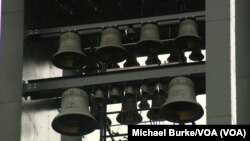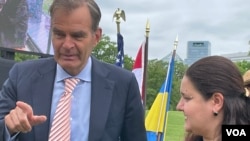More than 70 years ago the United States launched a massive reconstruction effort to help rebuild Europe following the end of the Second World War. This week, U.S. Treasury Secretary Janet Yellen said Ukraine will need similar assistance, as the U.S. Congress prepares to approve $40 billion in military, economic and humanitarian aid for Kyiv.
“Eventually, Ukraine will need massive support and private investment for reconstruction and recovery, akin to the task of rebuilding in Europe after 1945,” Yellen told an audience in Brussels Tuesday.
The Marshall Plan, officially known as the European Recovery Plan, was put in place in 1948 by the U.S. government. It is credited with generating a resurgence of postwar European industrialization and investment.
“Europe was devastated economically, and the economic aid that [the U.S.] provided helped us to build up our society again, to invest in education, in roads, in creating jobs again for the people, so the economy started to grow again, thanks to the Marshall Plan,” Andre Haspels, Dutch ambassador to the United States, told VOA.
Haspels spoke on the sidelines of an event hosted by the Netherlands this month rededicating a memorial in Washington that celebrates the alliance, which won the war and then helped rebuild Europe.
Located less than 500 feet from the iconic U.S. Marine Corps War Memorial, also known as the Iwo Jima memorial, a tall steel bell tower with a bronze finish known as the Netherlands Carillon was a gift from the Dutch government in the 1950s. Newly unveiled after an extensive three-year renovation in Europe, the bell tower thanks Americans for helping to liberate the country from Nazi occupation and for providing reconstruction assistance.
Haspels said the May 5 ceremony, which corresponds with Liberation Day in the Netherlands, was as much a presentation of a fully restored carillon as a reinforcement of the ideas and ideals behind it.
“The carillon, it’s also a symbol,” Haspels pointed out, adding that his country wanted to ensure that not only the instrument is tuned, the structure is solid, but younger generations are aware of “how important the transatlantic relationship is.”
“We have added three new bells to the existing carillon, so it went up from 50 bells to 53,” making it officially a grand carillon, Haspel said.
The three new bells were named after George Marshall, the architect of the U.S. recovery plan, Martin Luther King Jr. and Eleanor Roosevelt.
While King and Roosevelt symbolize commitment to civil liberty for all in the United States, the name George Marshall serves as a reminder of what is needed to build up a postwar nation in the Netherlands and all around the globe.
“The carillon is important—it shows the commitment to freedom and to liberty,” Haspels said.
That commitment is what Ukraine values now more than ever, said Oksana Markarova, Ukraine's ambassador to the U.S., who was invited to address the unveiling ceremony.
“Ukrainians, like Dutch people, like to grow things,” she said, describing her countrymen as “peaceful bread growers” forced to “put aside peaceful tools and fight for our freedom.”
Freedom, which Markarova called an essential feature of life with dignity, is closely tied to democracy: “something we all need in order to be who we are, in order to live peacefully in our own countries, in order to decide who we want to be, what we want to be, what government we want to elect, and change regularly.”
Echoing the Netherlands’ message of gratitude for the help it received in times of need, both to be freed from oppressors and reconstructed, Markarova said her country is grateful “towards all friends, partners and allies.”
“Because you cannot win wars today, like you couldn’t win wars in the previous century, without those who share your values and principles,” she said, calling for additional help from the United States, the Netherlands and other countries.
The reason is quite simple, she said. “Because we need to win.”

